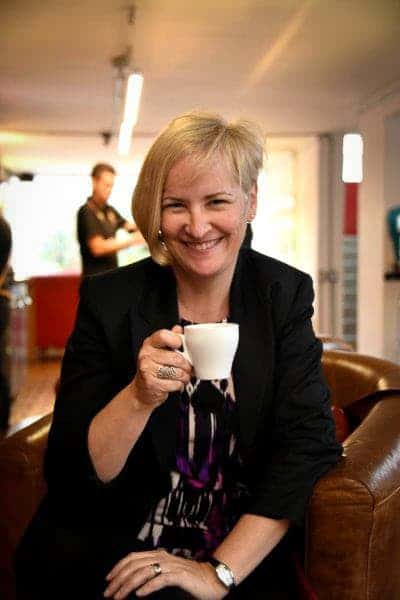Coffee Measurements: How Much Coffee Per Cup
You heated the water, and you’ve got your coffee maker ready to go. As you pick up the bag of coffee, you face a dilemma: How much coffee should you use for each serving?
We all go through that – even coffee experts. Yup. Myself included!
Depending on the amount of coffee you want to brew and how strong you want it to be, you need to adjust how much coffee you add to the filter. Keeping track of those numbers can be confusing.
Adding an interesting twist is that many people don’t have a kitchen scale to weigh their coffee grounds and water. When the coffee bag states that you should brew the coffee with 15 grams of coffee beans, what do you do?
Who Is This Article For?
Have you ever held your tablespoon or coffee scoop in hand and scratched your head, thinking: “How many tablespoons would that be?”
Well, not anymore. In this article, I’ll break down the coffee measurements you need to know to brew 1, 8, 10, and 12 cups of coffee.
Also, I’ll go over how to use tablespoons, scoops, grams, and ounces so that you never have to doubt how much coffee to add. Even if you don’t have a scale handy.
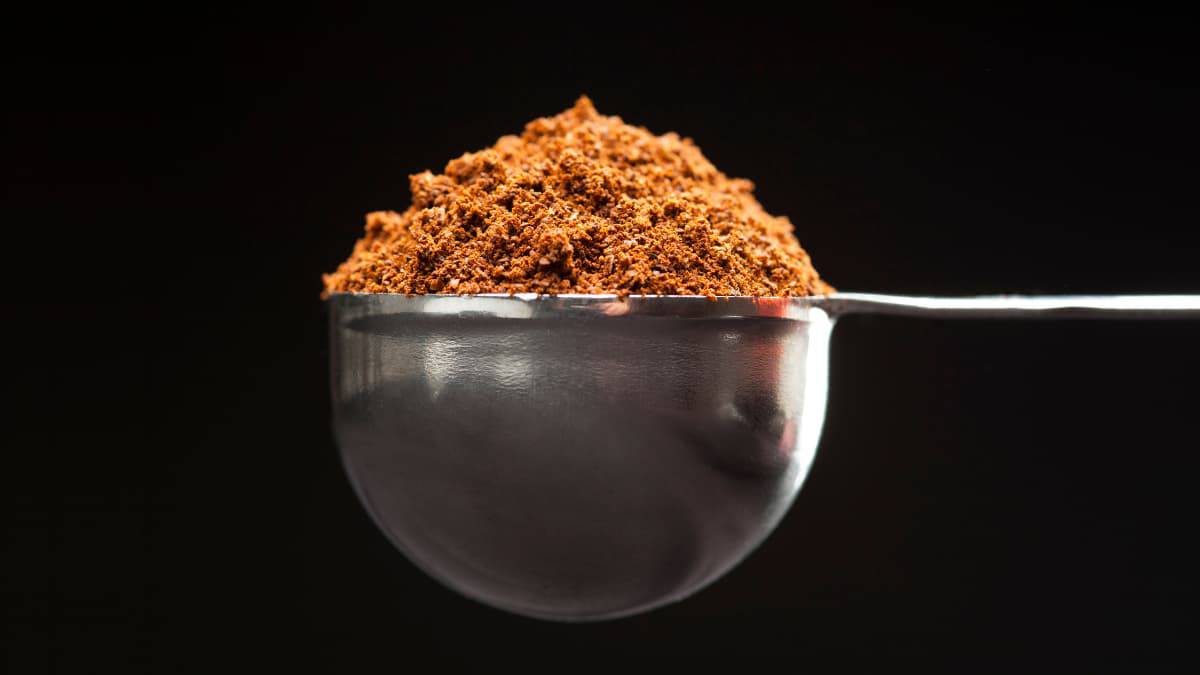
Why It’s Essential To Measure Coffee
Perhaps you’ve wondered what the measuring fuss is all about. I mean, can’t you just eyeball it and get a good brewed coffee?
As a coffee trainer who’s participated in many cuppings and competitions, I’ll tell you that coffee extraction is a science. The amount of coffee and water you combine to make your brew need to be exact to get consistent – and delicious – results.
So maybe you’ve already tried the eyeball measurement trick and realized that it’s a fast way to get an unpleasant, bitter, or weak brew. You’re convinced that it’s time to measure your coffee.
Then you run into another fact about coffee brewing. Coffee is generally measured by weight, not volume.
That’s why the bags of coffee you buy at the coffee shop are sold by weight (in ounces or grams) and not by volume (such as how many cups).
There’s a reason for that.
Grams or ounces measure mass, while tablespoons (or scoops and cups) measure volume.
The problem starts when you try to measure coffee by volume. For one thing, a tablespoon in one kitchen is not the same size as a tablespoon in another kitchen. Even tablespoons from your favorite measuring set might not be standard.
Also, measuring by volume is not exact because the density may be different. In other words, a tablespoon of dense coffee weighs more than a tablespoon of coffee that’s less dense. And you get different results because of that density.
Why does density change in coffee? Density can vary depending on the variety of coffee, its humidity level when roasted, and how dark it was roasted.
That’s why coffee experts always insist that coffee should be weighed, not measured by tablespoons. If you weigh the coffee, though, you’ll get consistent results every time you brew. No matter the density.
Yes, coffee measurements – especially by weight – are essential to brewing good coffee. Of course, not everyone has a kitchen scale or a coffee scale, and I’ll provide a workaround for that later in this article.
For now, I want to talk about another essential factor: ratios.
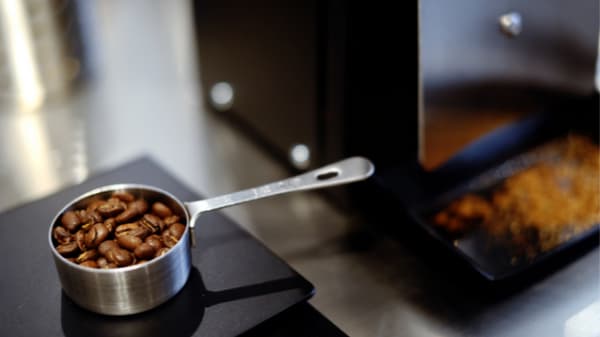
Ratios Matter
How much water you use compared to the amount of coffee is called the coffee to water ratio. The right coffee ratios tell us exactly what to do to get a good brew.
That bit of math is the backbone of coffee measurements and brewing. So it’s not surprising that baristas and other coffee experts get passionate about these coffee numbers (really!). Those measurements define, in part, how good the brewed coffee will taste.
Coffee to water ratios adjust according to many factors like grind size, brewing method, brewing time, and your personal tastes and preferences.
(If the math gets to be too much for you, check out our coffee to water ratio calculator that does the work for you.)
In fact, ratios are so important there’s even one that’s known as the Golden Ratio.
Golden Ratio
Perhaps you’ve heard of ratios in art, architecture, or in nature. Those numbers help define proportions and measurements.
In the coffee world, that Golden Ratio defines how much coffee to water you use to make a brew.
The Golden Ratio was created by the Specialty Coffee Association to help coffee drinkers, baristas, and others in the coffee industry determine the best amount of coffee to start with.
It’s a very easy way to measure coffee.
What is that golden number?
The Golden Ratio for coffee is 1:18. That means that for each gram of coffee, you need to use 18 grams of water.
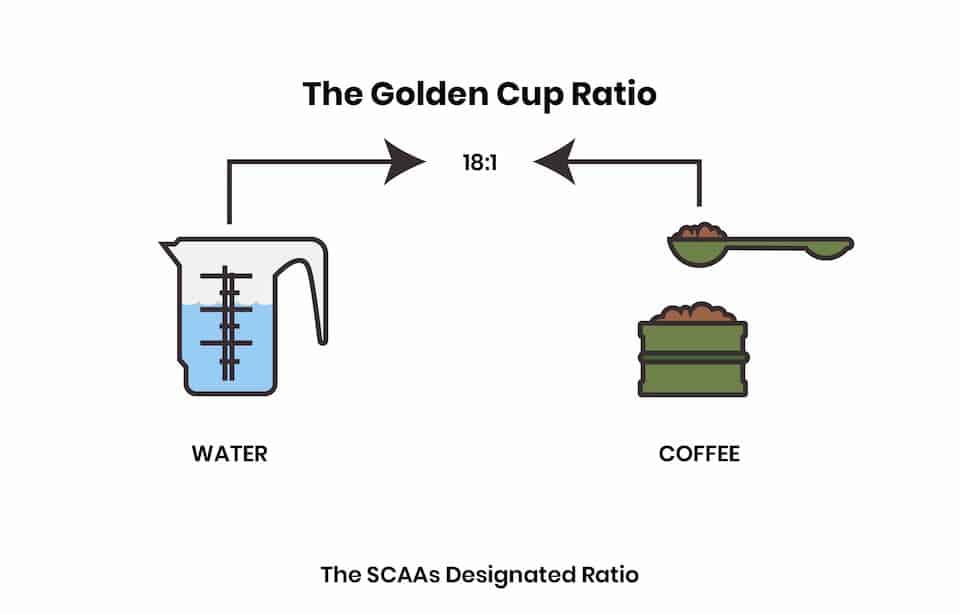
You’ll notice that coffee ratios are not a set amount of coffee grinds. Coffee ratios give you a comparison of how much to use. And therein lies the genius of ratios: you can use them to adjust your recipe to successfully brew one cup of coffee or huge amounts.
If you don’t like being locked into just one number, no problem.
The measurement of 1:18 gives you a place to start. After that, you can make changes depending on your tastes in coffee, the brewing method you use, and the coffee you use.
This may all sound confusing to you, but once you get used to it, those calculations are a lot of fun.
You can adjust the variables to your tastes and get just the brew you want. And when you measure with precision, you can get those results every time you brew.
It’s the beauty and science of brewing coffee.
As we already discussed, you can vary those numbers (with caution). Coffee ratios give you a safe place to start, a kind of coffee foundation. From there, you can create your own brewing experiments.
Just a quick word about cold brew: the coffee to water ratios are radically different because you brew with room temperature water for a longer period
Conversion Key To Measure Coffee
We discussed various coffee measurements, and, frankly, it’s confusing. That’s where a conversion key comes in handy.
A conversion key is a tool to help you figure out measurements. As I mentioned, one of the basics to keep in mind is that weight is one thing and volume another.
You can use a conversion key like this one to figure out the equivalents between cups, ounces, and grams. Or tablespoons and cups. Or scoops and grams.
For a shorter cheat sheet, keeps these weights and measurements handy:
1 cup = 8 oz = 227 grams
1 tablespoon = 1/16 of a cup = 5 grams
16 tablespoons = 1 cup = 8 oz
1 scoop = 2 tablespoons = 10 grams
When you use a scale, calculating ratios and how much coffee and water you should use is rather easy. It gets a bit trickier when you don’t have a scale and need to measure out your coffee and water.
I know this seems like a lot, but once you get the basics down, you’ll use them over and over. And while weight is more reliable than volume, if you generally buy the same type of coffee, you’ll get to know the volume that works best for your recipe.
Now we’re going to run through the amount of coffee beans you’ll need for specific serving sizes, based on the most frequently asked questions about coffee measurements.
So that this doesn’t get too involved with many variables, we’re going to stick to the most common way of brewing coffee, which is the drip method.
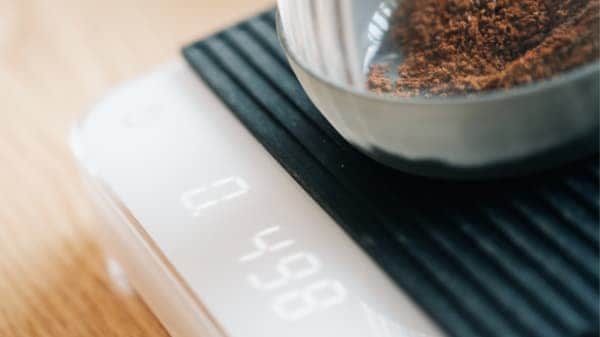
How Many Grams Of Coffee Per Cup?
In general, to brew drip coffee, you will use 14 grams of coffee per 8-ounces of water (236 ml). For a stronger brew, use 16 grams of coffee for the same amount of water.
How much coffee you use for each serving depends on two factors: the size of your coffee cup and how strong you want your coffee.
The size of your coffee cup will be different depending on your coffee maker, your tastes, and the type of coffee you drink.
While many coffee makers calculate coffee serving sizes at 4 ounces, many coffee drinkers don’t consider that to be a full serving.
For this article, I’ll stick to an 8-ounce measurement per serving since that’s the amount most people want to see in their mug. It’s also convenient because the measuring cup you have in your kitchen is also 8 ounces.
And while we talked about a 1:18 ratio, you can vary that if you’d like a stronger brew.
And what if you’ll be measuring with a tablespoon or coffee scoop? Let’s talk about that now.
How Many Tablespoons Per Cup?
If you don’t have a kitchen scale available, you need to measure coffee in some other way. You can use any tablespoon you have in your kitchen, as long as it’s an average tablespoon and not oversized.
An average tablespoon holds about 5 grams of coffee. Don’t use a heaping tablespoon; take a moment to level out the ground coffee on the spoon.
The amount of coffee that fits in a tablespoon can vary depending on the size of your tablespoon and the density of the coffee. A tablespoon of coffee can weigh anything from 5 grams to 9 grams, which is a big variation!
Also, a tablespoon of coarsely ground coffee will actually have quite a bit less coffee per volume than finely ground coffee.
If you measure with a tablespoon, brew one 8-ounce cup of coffee using three-level tablespoons of coffee.
If you need to brew a full pot of coffee, you’d be measuring out coffee for a long time with the tablespoon method. So to avoid the tedious measuring process, coffee scoops were invented.
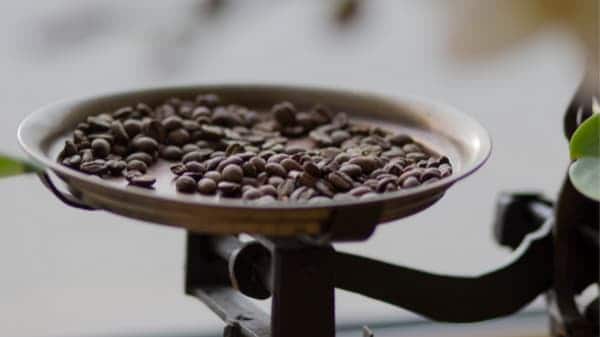
How Many Scoops In A Coffee Cup?
A typical coffee scoop cuts your work in half because it holds two tablespoons, or around 10 ml, of coffee.
Just dip your scoop into the bag of coffee, then level it off. The amount I give here is for a level coffee scoop, not a heaping one.
To brew one serving in a drip coffee maker you need 14 grams of coffee or one coffee scoop and a half.
To make the coffee stronger, you need just under 17 grams of coffee. That’s an extra 3 grams, which is about half a tablespoon. (I know that’s not a precise amount – that’s where using a scale is the best option).
See. Scoops of coffee can be pretty easy to figure out!
When you’re brewing larger amounts, how much coffee do you need?
How Much Ground Coffee For 8 Cups
Now that we know how much coffee you need for one cup of coffee, it’s easy to work out the numbers for 8 cups of coffee.
Since we’re calculating 8-ounce cups, that’s 64 ounces of water. You can measure it out with your typical kitchen measuring cups.
And remember that we want to use 14 grams of coffee for each serving. So for eight 8-ounce cups of coffee, you’ll need to use 112 grams of coffee for those 64 ounces of water.
If you’re truly allergic to math, feel free to use the coffee to water ratio calculator I mentioned before.
Now that you know how much coffee you’ll use, you need to figure out how to measure it out.
To use a tablespoon, you simply divide the total amount of coffee grounds (111 grams) by the 5 grams that fit in a typical tablespoon. That’s a whopping 22 tablespoons of coffee.
If you want to use a coffee scoop, use 11 scoops of coffee.
If you’d like to use measuring cups, 16 tablespoons fit inside a measuring cup.
To measure enough coffee for 8 cups of coffee, you can use one cup of grinds and add 6 tablespoons. Or 1 cup and 3 scoops of coffee.
If you’re hankering for a stronger coffee, you can increase that amount a bit and use 125 grams of coffee. Then, use the same amount of water – 64 ounces – and measure out 125 grams of coffee.
To measure out 125 grams of coffee using a tablespoon, you would need to use 25 tablespoons. That would take a while to measure out.
If you want to measure with a coffee scoop, use 12.5 scoops of coffee. And if you’d like to cut out some of that measuring time and use measuring cups, use one measuring cup and 9 tablespoons or 4.5 coffee scoops.
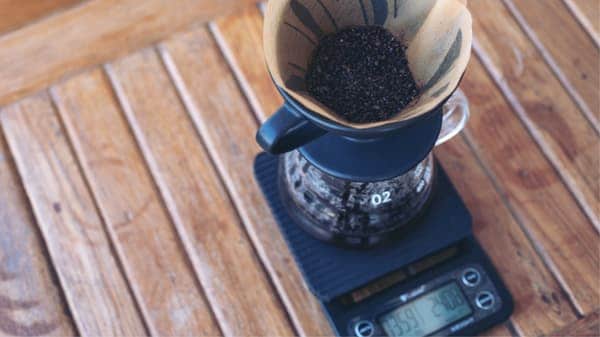
How Much Ground Coffee For 10 Cups
Many coffee makers go as far as a 10-cup capacity. So how do you measure out the coffee grounds for a full 10 mug pot?
Remember that each serving of coffee takes 14 grams of coffee. So for 10 cups of coffee, you will use 140 grams of grinds. In case you weigh out the water, those 10 cups of water equal 80 ounces of water (2,360 ml).
To measure out 140 grams of coffee, you can use 28 tablespoons or 14 scoops of coffee. I’m sure you’re considering the option of using measuring cups, which would be just 1.75. A lot simpler to measure out.
To increase the strength of the coffee, you can increase the amount of ground coffee to 156 grams. That’s 31 tablespoons, or 15 scoops of coffee, or 2 cups if you’re using measuring cups.
Now let’s take it one more step and talk about those coffee makers that brew a whopping 12 cups.
How Much Coffee For 12 Cups?
If you’re making coffee for an office or a party, you’ll want to know the amount of coffee grounds that go into a 12 mug pot of drip coffee.
Start with 96 ounces of water. Then you’ll put 166 grams of coffee in the filter basket. If you want to measure that by the spoonful, that would be 33 tablespoons.
If what you have on hand is a scoop, that would be 16 scoops of ground coffee. Hopefully, you have measuring cups on hand to cut down on the work, and you can just measure out 2 full measuring cups.
If your office mates request strong coffee, measure out 188 grams of coffee and the same amount of water. That’s about 37 tablespoons or almost 19 scoops. Of course, you want to know the cup measurement: it’s 2.3 measuring cups full of ground coffee.
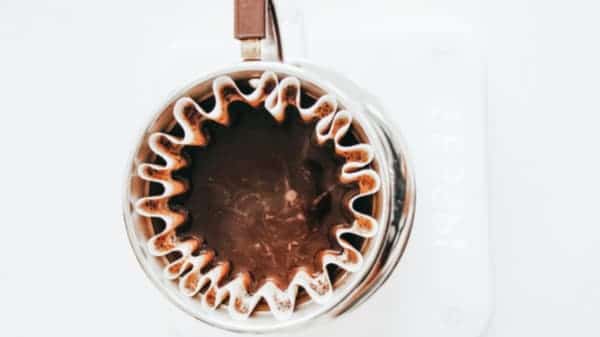
Wrapping Up How To Measure Coffee
Defining how much coffee and water to use to get the perfect brew involves a lot of details. But all that calculation is worth the effort because you’ll be rewarded with a rich, tasty coffee.
And when you work out all those details yourself, perhaps that well-brewed mug of coffee tastes even better. There’s no doubt about it: satisfaction adds to the taste experience.
If you don’t love math, keep a brewing chart handy. All you have to do is define how many cups of coffee you want to brew, and the chart will tell you the amount of coffee grounds and water to use. Happy brewing!

